To master natural pest deterrents in 7 days, start by accurately identifying pests and understanding their lifecycle. Set clear goals, then create a healthy garden using compost, companion planting, and proper watering. Use natural repellents like garlic or neem oil, and build physical barriers or traps with recycled materials. Regularly monitor pest activity, adjust your tactics as needed, and involve your community. Keep at it, and you’ll discover more effective techniques along the way to keep pests at bay naturally.
Key Takeaways
- Identify pests accurately and understand their lifecycle for targeted, effective natural control methods.
- Set clear goals and promote healthy, pest-resistant garden practices through soil enrichment and companion planting.
- Use natural repellents like garlic, neem oil, and herbs, applying them properly and supporting beneficial insects.
- Create physical barriers and eco-friendly traps using recycled materials to divert and capture pests effectively.
- Regularly monitor pest activity, record observations, and adapt strategies while engaging community resources for sustainable control.
Assessing Your Pest Problems and Setting Goals

Before you begin implementing natural pest deterrents, it’s essential to assess your pest problems thoroughly. Start by observing your garden or household areas to identify which pests are causing issues. Understanding the pest lifecycle helps you target interventions effectively, as knowing when pests are most vulnerable allows for better planning. Incorporate companion planting strategies by selecting plants that naturally repel pests or attract beneficial insects, reducing the need for chemical solutions. Set clear goals based on your observations—whether to eliminate specific pests or prevent future infestations. Keep track of pest activity and plant responses over time. This assessment phase helps you develop an informed, strategic approach to managing pests naturally, increasing your chances of success while maintaining a healthy environment. Understanding pest biology also plays a crucial role in timing your pest control efforts effectively.
Identifying Common Garden and Household Pests
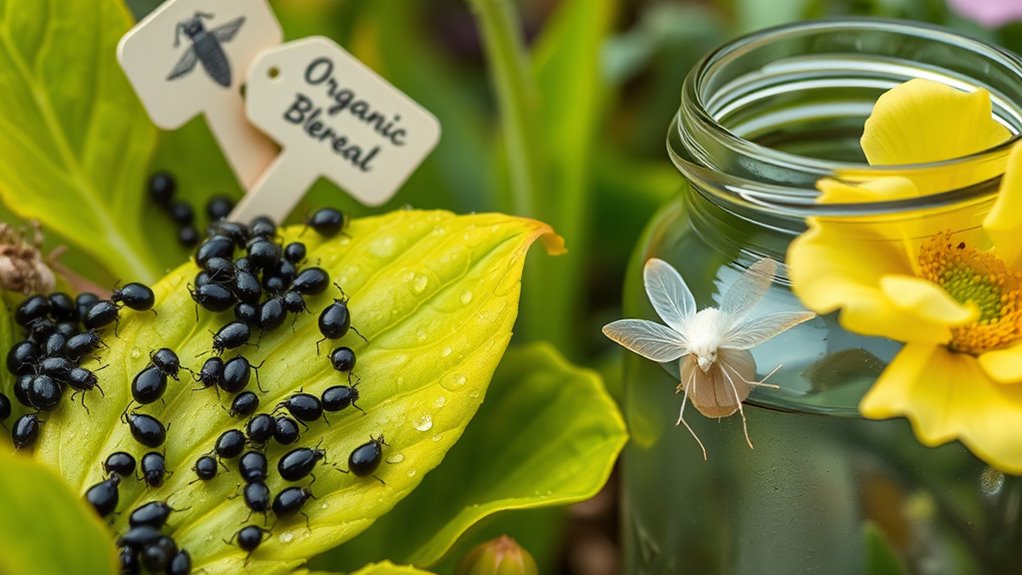
Knowing how to identify common garden and household pests is essential for effective natural pest control. Pest identification begins with a thorough garden assessment, observing plant damage, droppings, and pests themselves. Recognizing signs like chewed leaves, holes, or sticky residues helps you pinpoint the pest type. Familiarize yourself with frequent invaders such as aphids, spider mites, and whiteflies, as well as household pests like ants or silverfish. Pay attention to their appearance, behavior, and habitat. Accurate pest identification allows you to select targeted, natural methods to manage them without harming beneficial insects or your environment. Regular garden assessment keeps you aware of pest activity, so you can respond promptly and prevent infestations from escalating. Mastering pest identification is your first step toward effective, natural pest control. Additionally, utilizing vetted identification resources can improve your accuracy and confidence in managing pests.
Harnessing the Power of Natural Repellents
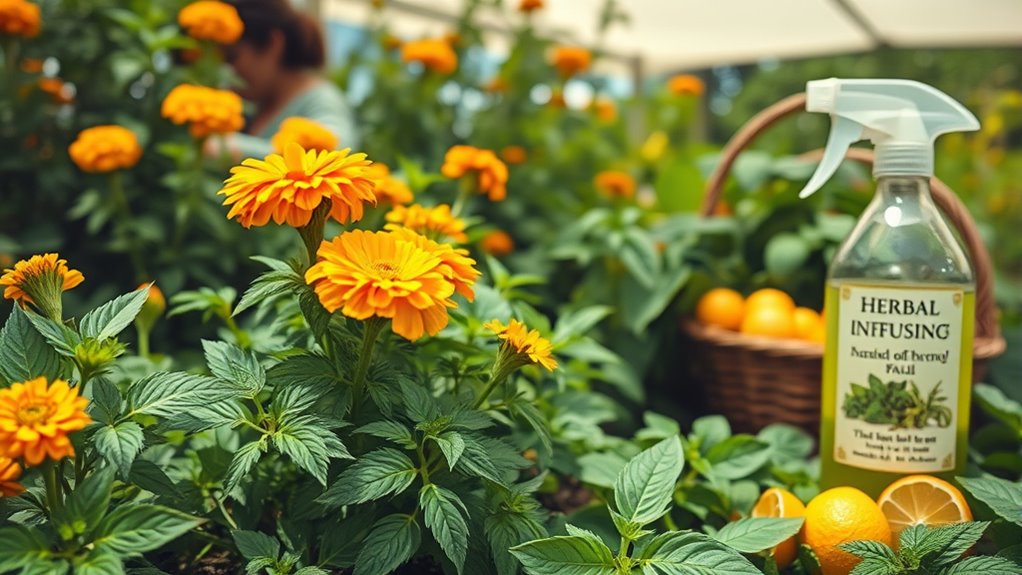
Natural repellents can be powerful tools in protecting your garden and home from pests. You’ll want to understand which repellents work best, how they function, and the best ways to apply them effectively. Mastering these techniques helps you keep pests at bay using safe, eco-friendly methods. Incorporating mindful decluttering strategies can also reduce hiding spots and breeding grounds for pests, making your pest prevention efforts more effective.
Essential Natural Repellents
Have you ever wondered how simple ingredients from your kitchen can keep pests at bay? Natural repellents like garlic, neem oil, and chili peppers are effective tools in your gardening arsenal. These repellents not only deter pests but also support healthy soil through companion planting, which enhances soil health and plant resilience. Using these ingredients regularly can reduce reliance on chemicals and create a balanced ecosystem in your garden. Incorporate these natural repellents into your routine for ongoing protection:
- Garlic spray to repel aphids and beetles
- Neem oil for a broad spectrum of pests
- Chili pepper spray for insects and rabbits
- Marigolds to deter nematodes and beetles
- Basil around crops to ward off flies and mosquitoes
Additionally, integrating garden design principles such as proper spacing and plant placement can further improve pest resistance. Together, they help cultivate a pest-resistant, thriving garden naturally.
How They Work
Understanding how natural repellents work can help you use them more effectively in your garden. These repellents often mimic plant compounds or odors that pests find unpleasant, confusing or overwhelming their senses. For example, certain aromatic herbs release scents that deter insects, while composting benefits can enhance soil health, encouraging plants to grow stronger and more resilient against pests. Natural predator support is also essential; attracting beneficial insects like ladybugs or predatory beetles helps keep pest populations in check naturally. When you apply repellents thoughtfully, you’re not just hiding pests but creating an environment that favors beneficial insects and healthy plant growth. Additionally, incorporating Preppy Dog Names can add a touch of charm and personality to your gardening companions, making the process more enjoyable. This holistic approach reduces the need for chemical interventions and fosters a balanced, pest-resistant garden ecosystem.
Application Techniques
Effectively applying natural repellents requires strategic techniques to maximize their benefits. To protect your plants while supporting soil health, consider the timing and method of application. Use sprays during early morning or late evening to minimize sun degradation. Incorporate companion planting to naturally deter pests, reducing the need for frequent applications. Guarantee repellents are evenly distributed around vulnerable plants for better coverage. Regularly test soil pH to maintain ideal conditions that support beneficial insects. Additionally, avoid over-application, which can harm soil microbes and beneficial insects. Here are some tips:
- Apply repellents after watering to enhance absorption
- Use organic oils or sprays compatible with soil health
- Combine repellents with companion planting strategies
- Reapply after heavy rain or watering
- Focus on pest-prone areas for targeted protection
- Incorporate aesthetic wall organization to create a visually appealing environment that can also support pest deterrence through strategic plant placement
Creating Homemade Pest Barriers and Traps
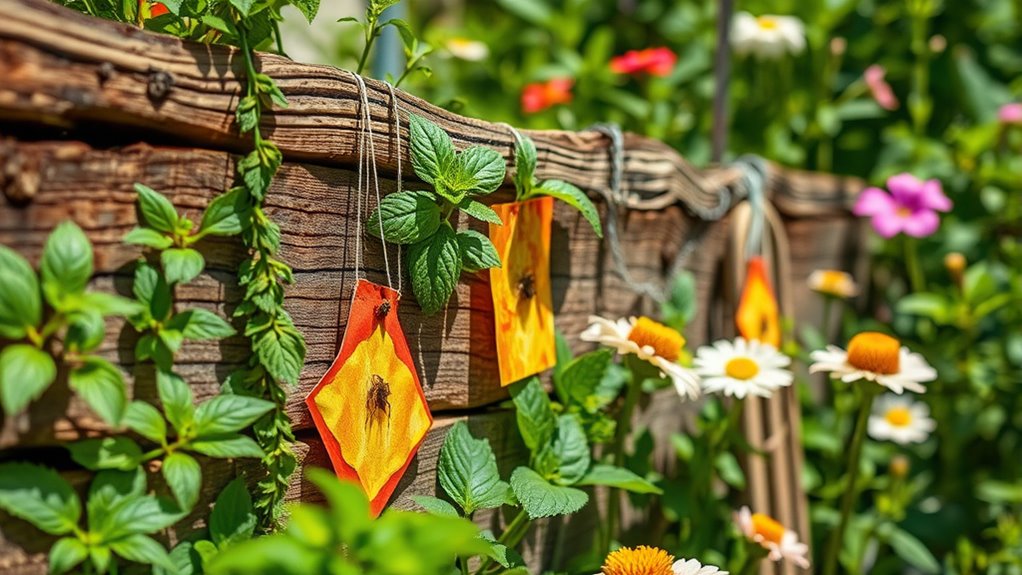
You can build simple barriers using everyday materials to keep pests out of your garden. Effective trap designs can catch invaders before they cause damage, saving your plants. Let’s explore easy DIY techniques to create these protective solutions. Incorporating natural pest deterrents can enhance your garden’s defenses without harsh chemicals Glycolic acid benefits.
DIY Barrier Techniques
Creating homemade pest barriers and traps offers a simple yet effective way to protect your garden without relying on chemicals. You can build physical barriers or use natural strategies to deter pests. For example, surround your plants with pest-resistant plants like marigolds or garlic, which naturally repel insects. Consider using garden hoops covered with fine netting to keep pests out or place crushed eggshells around vulnerable plants as a deterrent. Companion planting also helps, planting basil near tomatoes to repel flies. Additionally, create trap crops that lure pests away from your main garden. Here are some ideas:
- Fine mesh covers over seedlings
- Eggshell barriers around plants
- Companion planting with pest-resistant plants
- Raised beds with physical barriers
- Trap crops to lure pests away
- Incorporating high contrast visuals can help in monitoring pest activity and improving your pest management strategies.
Effective Trap Designs
Designing homemade pest traps is an easy and affordable way to reduce pest populations in your garden. Use sustainable trap materials like recycled plastic bottles, paper cups, or natural substances such as banana peels and citrus peels to create effective traps. Focus on trap placement strategies by positioning them near pest hotspots or along their travel paths to maximize catch rates. For instance, place sticky traps near plant crowns or soil edges where pests crawl or fly. Make sure your traps are accessible for easy maintenance and regularly check and empty them. By combining eco-friendly materials with strategic placement, you’ll enhance your pest control efforts without harming beneficial insects or the environment. Additionally, understanding pest aroma cues can help in designing more effective traps by leveraging their scent detection behaviors. Simple, effective, and sustainable trap designs help keep your garden healthy and pest-free.
Incorporating Beneficial Plants to Deter Pests
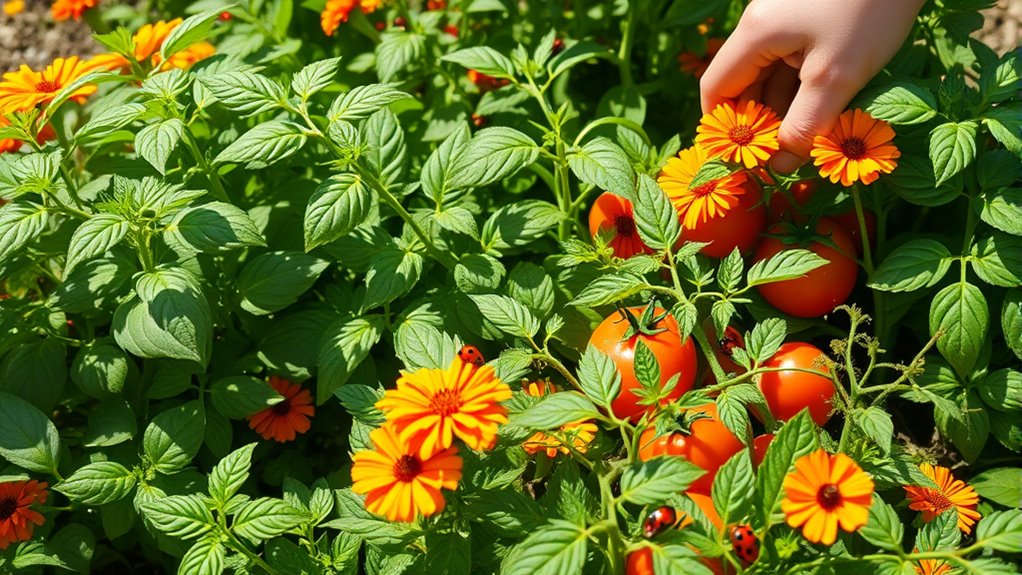
Incorporating beneficial plants into your garden can naturally deter pests and promote a healthier environment. Companion planting with aromatic herbs is a smart way to keep pests at bay while enhancing your garden’s diversity. You can plant herbs like basil, mint, or marigolds near vegetables to repel insects. These plants emit strong scents that confuse or deter pests, reducing the need for chemical solutions. Consider placing pest-repelling plants strategically around your garden for maximum impact.
- Use marigolds to deter nematodes and aphids
- Plant basil near tomatoes to repel whiteflies
- Grow mint to keep away ants and beetles
- Incorporate lavender for moths and mosquitoes
- Combine chives with roses to prevent aphid infestations
Maintaining a Healthy and Pest-Resistant Environment

Maintaining a healthy and pest-resistant garden requires consistent attention to soil health, plant vigor, and environmental conditions. You can achieve this by practicing companion planting, which encourages beneficial interactions between plants, reducing pest problems naturally. Healthy soil is the foundation; enrich it with compost and avoid compaction to promote strong root systems and nutrient uptake. When plants grow vigorously, they’re better equipped to fend off pests. Keep environmental conditions balanced by watering appropriately and providing proper airflow. Avoid overcrowding, which can create hiding spots for pests and encourage diseases. Regularly check your plants for early signs of trouble, and adjust your practices as needed. Incorporating sustainable harvesting practices and native plants can also help maintain ecological balance. By maintaining soil health and strategic companion planting, you create a resilient environment that discourages pests and supports lush, thriving growth.
Monitoring Progress and Adjusting Your Strategies
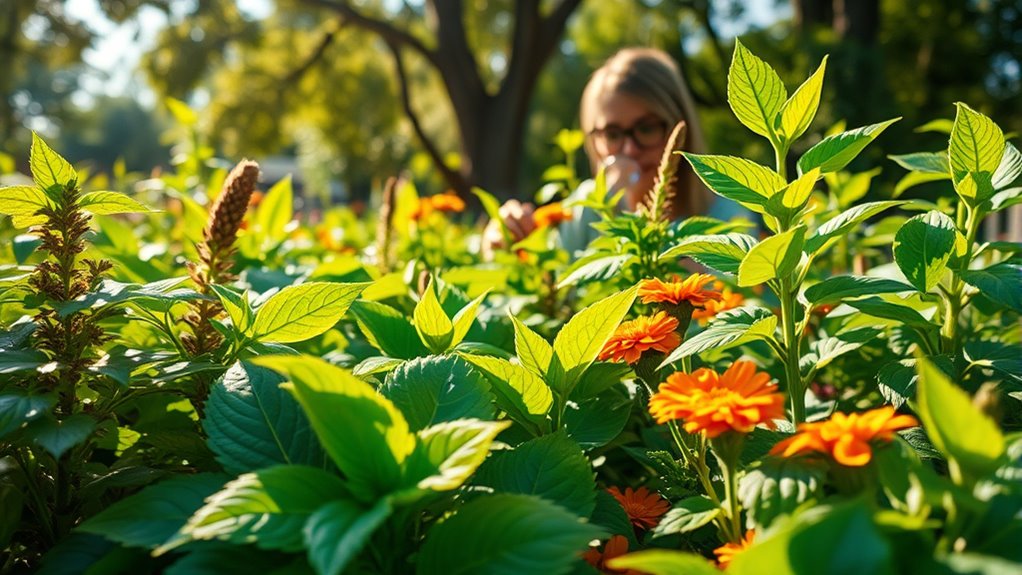
To effectively manage your garden’s health, you need to regularly monitor its progress and be ready to adjust your strategies as needed. Understanding the pest lifecycle helps you identify vulnerable stages and time your interventions effectively. Keep an eye on weather impact strategies, as changes in temperature and humidity influence pest activity and plant resilience. Regularly inspect plants for signs of pests and tracking patterns over time allows you to adapt your approach. Incorporating community engagement by sharing observations and strategies with fellow gardeners can also enhance your pest management efforts. Keep detailed records to inform future decisions.
Frequently Asked Questions
Can Natural Pest Deterrents Harm Beneficial Insects in My Garden?
Natural pest deterrents can be safe for beneficial insects if you choose selective options that target specific pests. You should avoid broad-spectrum solutions that might harm helpful bugs, focusing instead on natural methods like companion planting or neem oil. By practicing beneficial insect safety, you help maintain a healthy garden ecosystem. Always read product labels and apply treatments carefully to minimize risks to beneficial insects while controlling pests effectively.
How Often Should I Reapply Homemade Pest Repellents?
Think of your homemade pest repellent as a gentle rain shower for your garden. You should reapply it every 7-10 days to keep pests at bay, as its pest deterrent lifespan is limited. Regular reapplication guarantees your plants stay protected without overdoing it. Keep an eye on weather conditions, and reapply after heavy rain, to maintain that protective barrier, just like watering your plants to keep them healthy.
Are Natural Methods Effective Against All Types of Pests?
Natural methods can be effective against many pests, but they might not work for all types due to pest diversity and chemical resistance. Some pests develop resistance to natural deterrents over time, just like with chemicals. You should tailor your approach based on the specific pests you’re facing and consider combining different natural methods for better results. Stay observant and adapt your strategies to maximize effectiveness.
What Is the Best Time of Day to Implement Pest Control Measures?
Dawn and dusk are your best friends for pest control, as pest activity tends to peak during these times. By implementing measures early in the morning or late in the evening, you target pests when they’re most active and vulnerable. This ideal timing increases the effectiveness of your natural deterrents. So, keep an eye on the clock to outsmart pests and protect your garden naturally.
How Do I Prevent Pests From Developing Resistance to Natural Deterrents?
To prevent pests from developing resistance to natural deterrents, you should implement rotation strategies by alternating different methods like neem oil, garlic spray, and beneficial insects. Regular pest monitoring helps you identify infestations early and adjust your approach accordingly. This combination keeps pests off balance, reduces resistance buildup, and guarantees your natural deterrents stay effective over time. Stay vigilant and adapt your strategies as needed for ideal control.
Conclusion
By following these steps, you’ll turn your garden and home into a pest-free zone using natural methods. Stay consistent, and you’ll see pests fade away like a passing cloud. Remember, patience is key — a little effort now will pay off in a thriving, healthy environment. Keep your eyes open, adapt as needed, and enjoy the satisfaction of mastering natural pest deterrents. Before you know it, you’ll have a pest problem that’s well under control.










